This was published 9 years ago
Just like paradise: The lesser-visited islands of Fiji
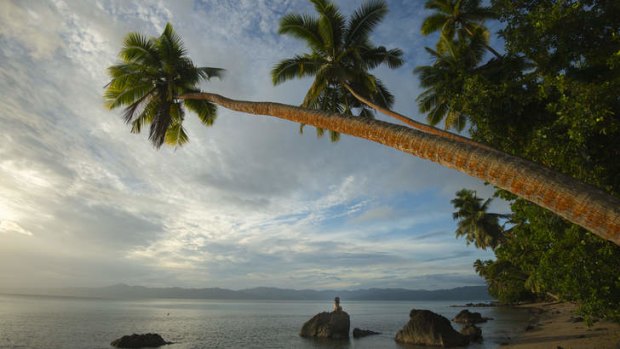
In the Fijian tropics.Credit: Getty Images
Caroline Gladstone encounters life in the lesser-visited islands of Fiji.
I hear the singing and the banging of drums before I locate their origin. Then off to port I see them - a flotilla of outrigger canoes approaching swiftly, paddled by the villagers of Kioa Island.
It's the welcoming committee and, for a minute, I fantasise I'm in a Road to ... movie (a la Bob Hope and Bing Crosby), where we explorers have chanced on some exotic shore whose inhabitants are either coming to greet us or interrogate us.
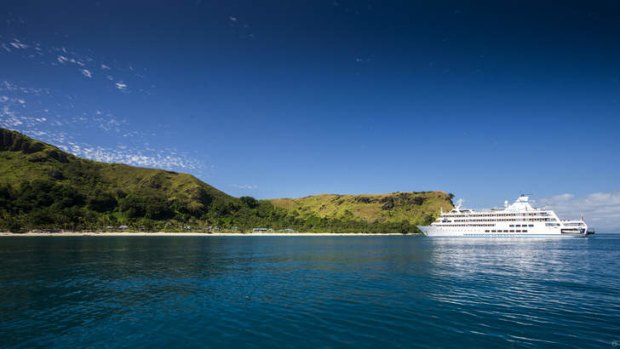
On the Reef Endeavour's Four Cultures Discovery Cruise.
Exotic it certainly is, for Kioa is a speck of rock just off the east coast of Vanua Levu, Fiji's second main island, and its people are Polynesian. Dressed in bright-red sulus (sarongs) and white T-shirts, with their flowing hair entwined in garlands, the village elders lead the dozen boats as a drummer beats a rhythm on a makeshift tin drum.
The 130-passenger ship Reef Endeavour visits Kioa four times a year, making it a special event for the islanders, the ship's Fijian crew and we passengers, who are relishing this adventure to such a remote patch of the Pacific.
We are part of the Four Cultures Discovery Cruise, which circumnavigates Vanua Levu over a week and visits islands that are home to Polynesians, Micronesians, Fijian-Indians and Fiji's native Melanesians.
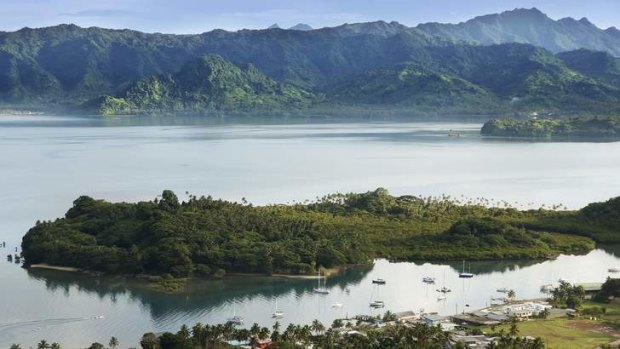
Savusavu Marina and Nawi Islet, Vanua Levu island, Fiji.Credit: iStock
Nautical greeting over, we clamber on board the ship's tenders and motor into Kioa's coral-dotted shore. We are escorted to the community hall, where the residents of the island's 80 households are waiting.
We walk under an arch that says "Talofa" and I recognise the word from a previous trip to Samoa. It's Polynesian for "welcome" and soon we learn just why these people are living here, far from home.
When the hubbub dies down in the riotously decorated hall, elder statesman Eddie relates the story of how 37 people from Tuvalu (formerly the Ellice Islands) left their homeland in 1947 to travel 1000 kilometres to resettle in Fiji.
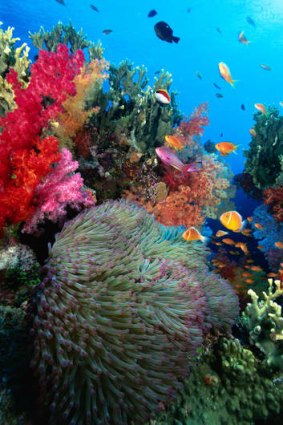
Marine life at Cat's Meow, Bligh Water, Vanua Levu Barrier Reef.Credit: Getty Images
They were the "volunteers" and, within a decade, more than 235 people followed in waves and made their home on the 21 square kilometre island.
"The place was naked, except for wild animals," Eddie says, adding that the sole survivor of the original group, 89-year-old Siapo Paka, lives in the "green-painted house".
With the speeches over, the entertainment begins and it's the most enthusiastic and infectious singing, dancing and drum beating I have witnessed.
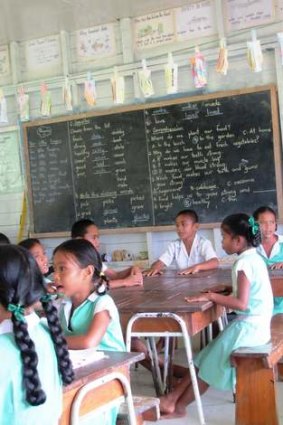
Kioa Island School.
Each song tells a tale of the long journey and the struggles to make a new life.
The original settlers left Vaitupu, one of Tuvalu's nine islands, to escape the overcrowding and because their charismatic, self-proclaimed leader, Neli Lifuka, had raised enough funds to buy Kioa from Fiji.
Eddie calls Kioa "paradise".
As I wander around the village grounds, three little girls show me their primary school, the church and the kindergarten. When it's time for high school, they say they will have to board in Taveuni (Fiji's third largest island), as they point out a land mass in the distance.
The next day, we anchor near Rabi Island, about 10 kilometres north of Kioa, and hear a similar story, but told by people of Micronesian descent. Rabi's four towns are populated by the Banabas, who originate from Banaba Island (formerly Ocean Island), in the Kiribati group.
They resettled in Fiji just after World War II at the behest of their British rulers, because of the ongoing destruction caused by phosphate mining (some say it was to get them out of the way so mining could continue). Their story is not as happy - they were initially given tents as shelter and 40 of the older settlers died soon after arriving in Rabi, but the community has since flourished and residents now have dual-Kiribati and Fijian citizenship.
I notice the dancers are dressed less modestly, compared with their Kioa neighbours. Gone are the T-shirts and fabric skirts. The Rabi girls wear woven pandanus, palm-leaf bras and necklaces and their lustrous dark hair reaches down to their waists. The young boys, grassed-skirted and wearing wild head gear, are having the time of their lives working themselves into a feverish romp. It's loud and joyous and, when it's over, the music maestro flicks the switch to a disco beat and urges passengers on to the dance floor.
That afternoon we cruise to the quieter side of Rabi, to Albert Cove, for snorkelling. It's one of those idyllic spots you dream about that outdoes any picture postcard.
Captain Cook Cruises has honed this itinerary well. The mornings are devoted to cultural visits and, in the afternoon, the ship is moored off tranquil beaches for swimming, snorkelling and lazing about. On this early-May sailing, the weather is ideal.
The cruise line has been operating the Four Cultures cruise for 18 months and, while there are only 38 passengers on my trip, the ship can take 130 people.
It is one of the two "discovery" itineraries that explore the lesser-visited islands of the north. In 2012, I took a Colonial Heritage cruise to Vanua Levu, Taveuni and the former, time-warped capital of Levuka. While both cruises are fascinating, I'm just a little more taken with this itinerary, perhaps because of the enthusiastic interaction we have with so many local people.
Our next cultural immersion is the classic Fijian experience - the Melanesian - and we have several opportunities to savour its many facets. After rounding the eastern tip of Vanua Levu, we cruise to Kia.
It's another volcanic isle, along with Mali Island, which we visit in the evening for a lovo feast. It is ringed by the Great Sea Reef, the third biggest barrier reef in the world.
In the morning, we meet a contingent of Kia islanders who make their living fishing and gathering sea urchins. Although the little school is closed for the holidays, the administrator gratefully receives our gifts of school supplies and money.
Kia is one of seven primary schools supported by Captain Cook Cruises. Passengers are alerted before sailing of the chance to bring items to donate. One Australian couple opens a bag full of soccer and rugby balls to the delight of the young boys, who quickly pounce on them and run off to the footy field.
Our final cultural interaction comes at Labasa, the largest town on Vanua Levu. Most of the 28,000-strong population are Indian-Fijians, descendants of indentured labourers brought to Fiji from 1879 to 1916 to work in the sugarcane plantations.
Apart from the city's one set of traffic lights (the only ones on Vanua Levu), the big attraction is the Nagigi Naag Mandir Temple, a Hindu place of worship also called Cobra Rock. As we shuffle shoeless by a huge cobra-shaped stone, the priest tells us the rock is revered, as it has grown bit by bit each year for more than 120 years.
An Indian dance performance takes place in the city's civic centre, but compared with the other cultural shows, it is the least interesting. It's a pity, because the three young dancers, who probably practised for ages, are eager to please. The bland hall and lack of live music cannot compete with the earlier high-spirited concerts set in their authentic backdrops.
The ship itself is looking smart, having just completed an "enforced" refurbishment after it was damaged by Cyclone Evan.
The 65 cabins and suites are newly carpeted, painted and refurnished, and the dining room and sundeck have had complete makeovers.
Captain Cook Cruises likes to say it's a "three-star ship with five-star service". However I would be inclined to put the ship a notch higher and definitely rate the experience as stellar.
The writer travelled as guest of Captain Cook Cruises Fiji.
TRIP NOTES
GETTING THERE
Virgin Australia flies daily to Fiji from Sydney. Return fares are from $682. See virginaustralia.com.au.
CRUISING THERE
Four Cultures Discovery cruise operates about four times a year, departing on a Tuesday. The ship leaves from Port Denarau, 15 minutes from Nadi International Airport. The next departure is on September 2, then January 6, March 3, July 7 and September 1, 2015. A deal , from $2067 a person twin share, is offered for the next departure. See captaincook.com.fj.
MORE INFORMATION
Sign up for the Traveller Deals newsletter
Get exclusive travel deals delivered straight to your inbox. Sign up now.